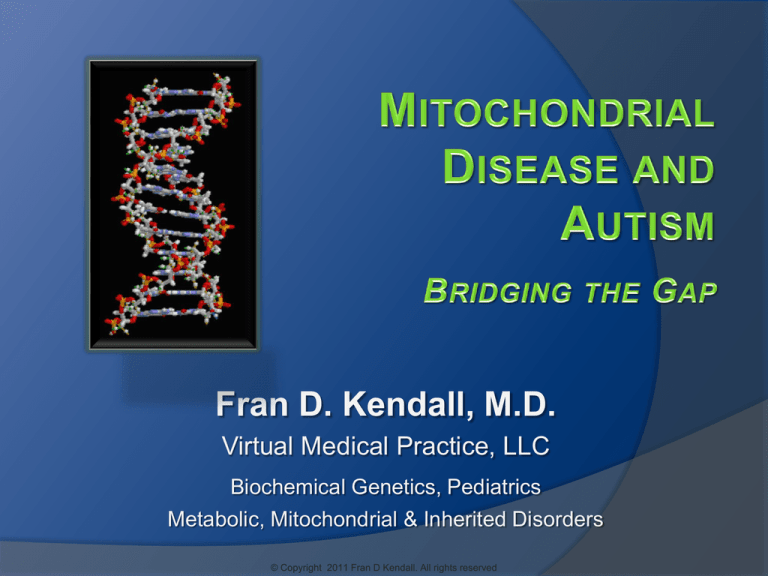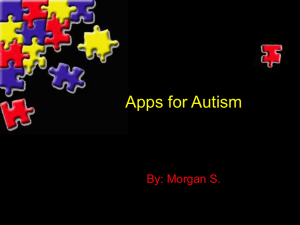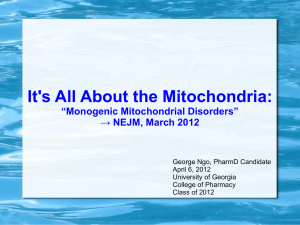
Fran D. Kendall, M.D.
Virtual Medical Practice, LLC
Biochemical Genetics, Pediatrics
Metabolic, Mitochondrial & Inherited Disorders
© Copyright 2011 Fran D Kendall. All rights reserved
To provide basic background information on
Mitochondrial Disease, its clinical features,
diagnosis, treatment, prognosis, inheritance
and to discuss its association with
Autistic Spectrum Disorders (ASD).
Dr Kendall and Virtual Medical Practice have
no financial interest in any laboratory.
© Copyright 2011 Fran D Kendall. All rights reserved
What are Mitochondria?
What is Mitochondrial Disease?
© Copyright 2011 Fran D Kendall. All rights reserved
Smallest functioning unit
of our bodies
Many cells together
make up tissues
Many sheets of tissues
make up our organs
© Copyright 2011 Fran D Kendall. All rights reserved
Located inside our body
cells
Composed of an inner
and outer membrane
The energy producing
pathway is the
respiratory chain
The respiratory chain
consists of 5 complexes
(groups of chemicals)
that produce ATP
© Copyright 2011 Fran D Kendall. All rights reserved
Oxygen & phosphate
used to make energy
Composed of five
complexes or groups of
chemicals with a total of
~90 subunits
Energy packets are
known as ATP
© Copyright 2011 Fran D Kendall. All rights reserved
© Copyright 2011 Fran D Kendall. All rights reserved
Found in 1 in 4,000 individuals
Carrier rate of common mtDNA
mutations may be as high as 1
in 200
Caused by an alteration in our
inherited blueprint (gene
mutation) or “toxic” affect of
external factor such as
medication
Results in decreased energy
production and localized or
widespread problems
© Copyright 2011 Fran D Kendall. All rights reserved
There are hundreds of genes involved in coding for the various
proteins and other compounds involved in OXIDATIVE
PHOSPHORYLATION or mitochondrial energy production
These genes are contributed by two sets of inherited genetic
material; the nuclear genes located inside the nucleus of our
body cells and mitochondrial genes found inside the
mitochondria of our cells
Nuclear genes are inherited from both parents and
contribute the vast majority of the information needed for energy
production
Mitochondrial genes are inherited EXCLUSIVELY through
mom and contribute the remaining information
© Copyright 2011 Fran D Kendall. All rights reserved
Approximately 850 proteins are encoded for by the nuclear
mitochondrial genes
Many of these proteins are responsible for the control of electron
transport chain structure and function and assembly
Autosomal recessive inheritance of nuclear gene defects is
probably the most common etiology of pediatric patients with
mitochondrial disorders.
© Copyright 2011 Fran D Kendall. All rights reserved
Inherited exclusively through the maternal line
Circular molecule, a number of copies in each mitochondrium
(5-10 copies typical)
16,569 bases or pieces and 37 genes
Mutated mtDNA may be present in varying amounts with wild
type DNA (heteroplasmy)
© Copyright 2011 Fran D Kendall. All rights reserved
© Copyright 2011 Fran D Kendall. All rights reserved
© Copyright 2011 Fran D Kendall. All rights reserved
BRAIN
Developmental Delays
Migraines
Seizures
Dementia
Autistic Features
Atypical Cerebral Palsy
Neuro-psychiatric Disturbances
Mental Retardation
Strokes
© Copyright 2011 Fran D Kendall. All rights reserved
NERVES
Absent reflexes
Fainting
Neuropathic pain
Weakness (may be intermittent)
Dysautonomia - temperature instability & other dysautonomic
problems
PANCREAS & OTHER GLANDS
Diabetes and exocrine pancreatic failure (inability to make
digestive enzymes)
Parathyroid failure (low calcium)
© Copyright 2011 Fran D Kendall. All rights reserved
MUSCLES
Weakness
Cramping
Hypotonia
Muscle pain
GASTROINTESTINAL PROBLEMS
Pseudo-obstruction
Dysmotility
Irritable bowel syndrome
Gastroesophogeal reflux
Diarrhea or constipation
© Copyright 2011 Fran D Kendall. All rights reserved
KIDNEYS
Renal tubular acidosis or wasting
HEART
Cardiomyopathy
Cardiac conduction defects (heart blocks)
LIVER
Liver failure
Hypoglycemia (low blood sugar)
© Copyright 2011 Fran D Kendall. All rights reserved
EARS & EYES
Visual loss & blindness
Ptosis
Ophthalmoplegia
Optic atrophy
Hearing loss and deafness
Acquired strabismus
Retintis pigmentosa
SYSTEMIC
Failure to gain weight
Chronic Fatigue
Unexplained vomiting
Short stature
Respiratory problems
© Copyright 2011 Fran D Kendall. All rights reserved
Central Nervous system (Brain) problems such as
developmental delays including AUTISM AND
AUTISTIC FEATURES, loss of function, seizures,
hypotonia & weakness
Failure to thrive
Chronic fatigue
Gastrointestinal issues such as chronic constipation
Autonomic dysfunction such as irregular heart rate and
blood pressure and temperature instability with heat
intolerance.
© Copyright 2011 Fran D Kendall. All rights reserved
Typical brain changes suggestive of Leigh disease or
abnormalities in white matter
Persistent, significant elevations in lactate (especially if
in the brain) and other specific biochemical features
Problems in many body systems suggestive of
mitochondrial disease
Strong family history of mitochondrial disease
© Copyright 2011 Fran D Kendall. All rights reserved
Clinical features, physical findings and minimal
laboratory/radiographic studies, example specific brain
lesions as seen in Leigh disease
Clinical phenotype consistent with one of the well
described subtypes of mitochondrial disease, such as
MELAS and confirmed by gene test.
Clinical features and findings suggestive of
mitochondrial disease – tissue studies completed.
© Copyright 2011 Fran D Kendall. All rights reserved
© Copyright 2011 Fran D Kendall. All rights reserved
Abnormalities in mitochondrial
structure/size/shape/number on tissue biopsy
Enzymatic abnormalities on testing of the energy
producing system (respiratory chain or electron
transport chain)
Specific DNA changes that cause mitochondrial disease
© Copyright 2011 Fran D Kendall. All rights reserved
© Copyright 2011 Fran D Kendall. All rights reserved
Complex I nuclear gene mutations - example
NDUFV1 patients with leukodystrophy and
myoclonic epilepsy
Complex IV assembly gene mutations example SURF1 mutations associated with
Leigh disease
© Copyright 2011 Fran D Kendall. All rights reserved
MELAS (Mitochondrial Encephalomyopathy Lactic
Acidosis and Stroke Like Episodes) due to tRNA
3243 mtDNA mutation
MERRF (Myoclonic Epilepsy and Ragged Red
Fibers) due to tRNA 8344 mutation
© Copyright 2011 Fran D Kendall. All rights reserved
Quite variable but typically progressive over time
Patients can face severe disabilities and early death
Many patients stabilize or show improvements with
institution of care
Problems typically worsen with stressors such as
illness and surgery
© Copyright 2011 Fran D Kendall. All rights reserved
Symptomatic – treat existing problems
Preventative – early detection of associated
problems
Therapeutics very limited and include use of
Coenzyme Q10
© Copyright 2011 Fran D Kendall. All rights reserved
Autosomal Recessive Inheritance
© Copyright 2011 Fran D Kendall. All rights reserved
Maternal Inheritance
© Copyright 2011 Fran D Kendall. All rights reserved
Autosomal Dominant forms
Sporadic
X-linked
© Copyright 2011 Fran D Kendall. All rights reserved
Edison Pharma EPI 743 trial for Leigh Disease and
MELAS patients
Hemopoietic stem cell transplant for MNGIE
Elimination of mtDNA mutation with nuclear
transplant into healthy egg cells
New less invasive testing including buccal swab
enzyme testing and expanded gene panels to
identify hundreds of the known mito genes
© Copyright 2011 Fran D Kendall. All rights reserved
Autism and Mito
© Copyright 2011 Fran D Kendall. All rights reserved
A complex neurobiological disorder that typically
lasts throughout a person’s lifetime, is a part of a
group of disorders known as autism spectrum
disorders (ASD) and affects the ability to
communicate and relate to others
Also associated with rigid routines and repetitive
behaviors
1 in 90 individuals is diagnosed with autism
making it more common that pediatric cancer,
diabetes and AIDS combined
Occurs in all racial, ethnic and social groups and is
4 times more likely to affect boys than girls.
An underlying diagnosis is established in only
2% - 36% of cases
© Copyright 2011 Fran D Kendall. All rights reserved
One 2005 population based study in Portugal
suggested that 7.2 out of 100 patients with
ASD have an underlying mito disorder.
A 2007 study by the same group revised their
population figures and noted 4.1 out of 100
patients with autism had underlying
mitochondrial disease.
Although mito appears to be a rare cause of
autism, it is one of the more common definable
causes of ASD.
© Copyright 2011 Fran D Kendall. All rights reserved
One study evaluated five patients with ASD and
family histories of mitochondrial DNA diseases.
Three patients had isolated autistic features and two
had additional neurological findings.
Two patients had the common MELAS A3243G
mutation.
One patient had mtDNA depletion.
© Copyright 2011 Fran D Kendall. All rights reserved
Weissman et al reported the association of ASD
with the mtDNA A4295G mutation in a 15 year
old with a number of other neurological findings
including hearing loss.
© Copyright 2011 Fran D Kendall. All rights reserved
Children with ASD are far more likely to have a
defect in their ability to produce energy than
typically developing children
Discovered widespread reduced mitochondrial
enzyme function among autistic children,
affecting complex I in 60% of the patients
Association established utilizing WBC
(lymphocyte) testing
© Copyright 2011 Fran D Kendall. All rights reserved
Children on the autism spectrum also reside
along a spectrum of mitochondrial dysfunction of
varying severity
Emphasized the need for ASD children to be
screened for possible mitochondrial dysfunction
citing improvements in children with ASD & mito
dysfunction after initiation of mito disease
management
© Copyright 2011 Fran D Kendall. All rights reserved
The link between mitochondrial dysfunction
and autism is greater than suspected
It remains uncertain if this association is due to
a primary defect in mitochondrial functioning
due to gene mutations or dysfunction caused
by other factor(s).
Mitochondrial disease should be considered
when associated with other neurological and
body system complications and/or a family
history of mitochondrial disease.
© Copyright 2011 Fran D Kendall. All rights reserved
TIER 1 – basic work up recommended for all patients
CHROMOSOME MICROARRAY STUDIES
COMPLETE METABOLIC PANEL, CBC, CPK
AMMONIA LEVEL
LACTATE AND PYRUVATE LEVELS
CARNITINE, PLASMA TOTAL AND FREE
COENZYME Q10 LEVEL
PLASMA AND URINE AMINO ACIDS
URINE ORGANIC ACIDS
PLASMA ACYLCARNITINES
THYROID FUNCTION TESTS
list is located on our website, www.virtualmdpractice.com
© Copyright 2011 Fran D Kendall. All rights reserved
TIER 2 – depends on clinical features & results of Tier 1 testing
MITOCHONDRIAL ENZYME AND/OR DNA TESTING
RETT SYNDROME DNA TESTING
PTEN MUTATIONAL ANALYSIS
NLGN3, NLGN4X, SHANK3, SNRPN GENE TESTING
LYSOSOMAL ENZYME TESTING
PEROXISOME DISEASE TESTING (VLCFAS)
CSF STUDIES FOR LACTATE AND PYRUVATE, AMINO ACIDS AND
NEUROTRANSMITTERS
BRAIN MRI
list is located on our website, www.virtualmdpractice.com
© Copyright 2011 Fran D Kendall. All rights reserved
For implementation of treatment & protocols
Monitoring in affected individuals
To determine recurrence risks for future
children
To determine risk for other family members
© Copyright 2011 Fran D Kendall. All rights reserved
© Copyright 2011 Fran D Kendall. All rights reserved
and
you can follow us on Facebook!
www.facebook.com/DrKendallVMP
w w w. vi rtu al md p racti ce. co m
info@virtualmdpractice.com
4 0 4 . 7 2 0 . 0 8 2 0 Vo i c e | 4 0 4 . 6 0 1 . 9 9 3 1 f a x
© Copyright 2011 Fran D Kendall. All rights reserved






